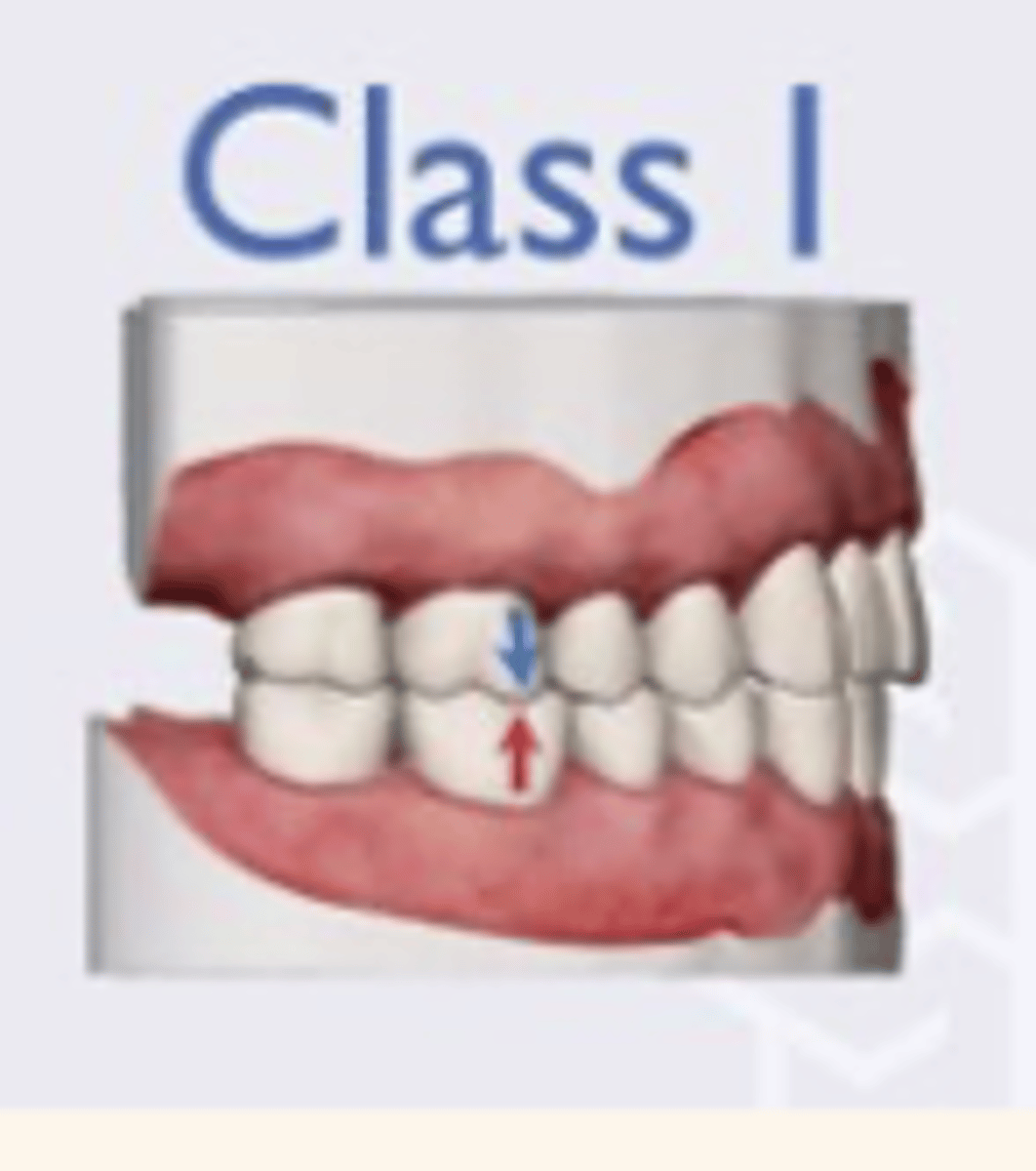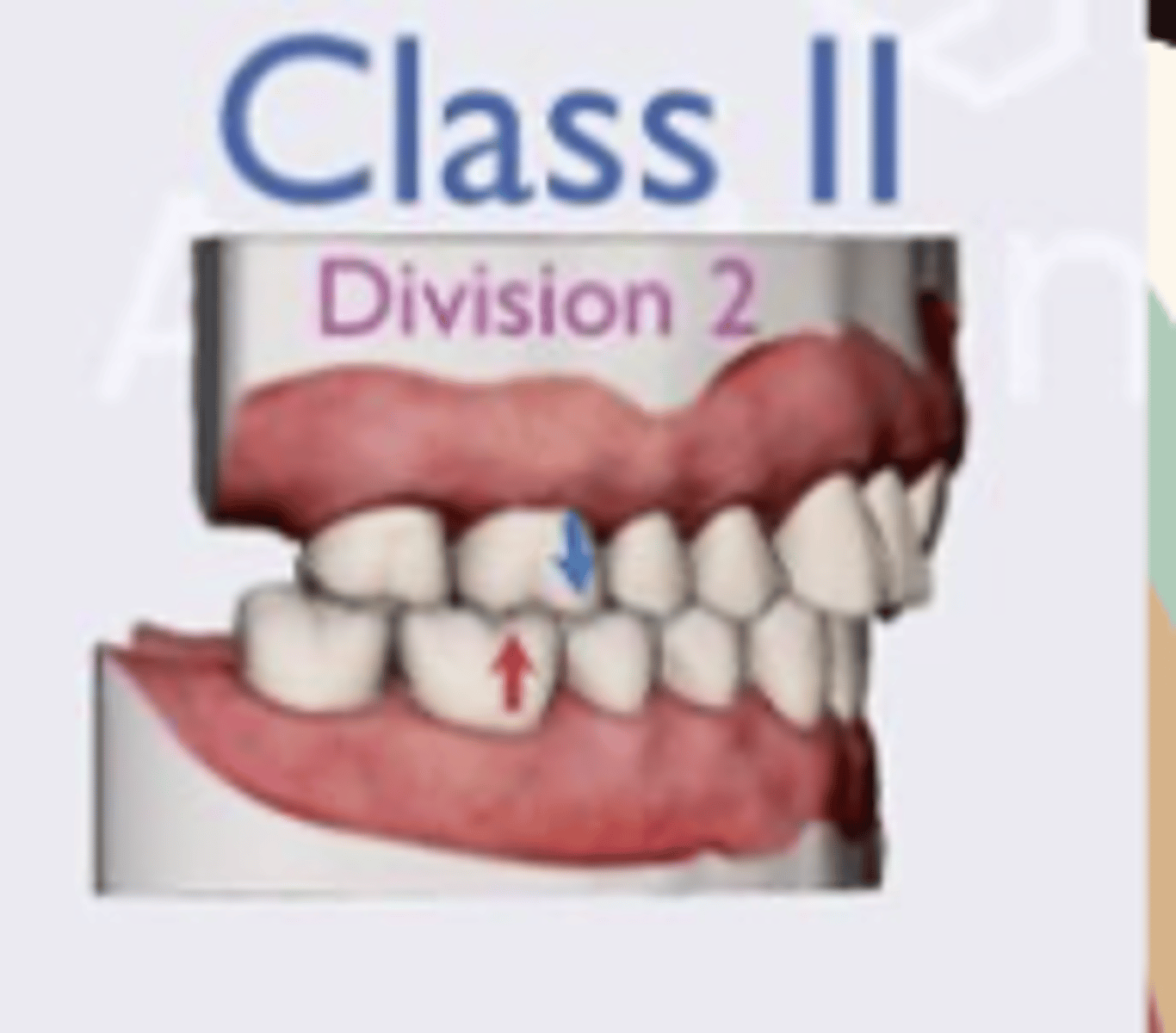Chapter 20: Occlusion
1/170
There's no tags or description
Looks like no tags are added yet.
Name | Mastery | Learn | Test | Matching | Spaced |
|---|
No study sessions yet.
171 Terms
What is Occlusion?
The contact relationship between the teeth when the jaws are in a fully closed and the relationship between the teeth in the same arch.
When does occlusion develop?
As the primary detition erupts
What are the interrelated factors to occlusion?
-Musculature
-Neuromuscular patterns
-TMJ functioning
-Tongue functioning
-Tongue posture
-Orofacial behaviors
-Habit patterns
What rarely exists but is the standard and basis for treatment relating to occlusion?
Ideal occlusion
What is centric relation (CR)?
The end point of the closure of the mandible (complete retraction).
What guides the mandible to its most posterior position in centric relation?
Healthy muscles and bony joint contours.
Even though a patient is rarely in CR, what is it?
A baseline measurement from which to evaluate a patients occlusion because it can be easily repeated.
When are patients typically in centric relation?
Patients are rarely in this position except during swallowing.
What is the purpose of centric relation in dentistry?
It is used to evaluate a patient's occlusion.
What's another word for centric occlusion?
Habitual occlusion
What is centric occlusion?
The voluntary position of the dentition that allows the maximum contact when the teeth occlude
What is the ideal/standard position of the detition?
Centric occlusion
When teeth are in the position of centric occlusion, what do each tooth of one arch occlude?
Each tooth of one arch is in occlusion with 2 others in the opposing arch.
When teeth are in CO, all teeth of one arch are in occlusion with two except for which teeth?
The mandibular centrals and maxillary third molars.
What does centric occlusion promote?
Equal forces of impact on occlusion
What is another benefit of centric occlusion?
If one tooth lost, the alignment of the opposing jaw is not immediately disturbed
If the tooth is lost for a longer period of time, what occurs?
The teeth become inclined and misaligned and overeruption or supereruption of the tooth opposing space then occurs.
Tooth loss can result in what?
Occlusal disharmonies
What is the occlusion equation?
CR=CO
What should the dentition ideally be in when the mandible is in centric relation?
Centric Occlusion
What is the typical position of the patient when maintaining freeway space?
Centric Resting Position
What is functional shift?
The sliding of the lower jaw to avoid occlusal interference to achieve maximum intercuspation
What is the usual distance of the slide from CR to CO?
1mm or less
What should be noted if there is a slide or shift in the dentition from CR to CO?
CR ≠ CO
What is the most often cause of centric relation not equaling centric occlusion?
Premature contacts or teeth initially contacting before the other teeth since all of the teeth should ideally contact at the same time.
What is the first system to classify occlusion?
Angle classifications of malocclusion
What does the Angle classifications of occlusion look at?
First molar relationship. Based on the concept that the maxillary first molar is the key to occlusion.
What is the classification system based on?
Relationship of the teeth and not the skeletal considerations that are due to disproportionate size or position of the jaws.
What is the characteristic of Class I occlusion?
MB cusp of maxillary 1st molar occludes with the buccal groove of the mandibular 1st molar

What is the characteristic of the canine positions for class I?
Maxillary occludes with the distal half of the mandibular canine and medial half of mandibular first premolar.
What is Class I noted by?
Ideal mesiodistal relationship with some protrusive or restrusive discrepancies.
What is the characteristic of Class II occlusion?
The MB cusp of the maxillary first molar occludes medically to the MB groove of the mandibular first molar.
What defines Division 1 of Class II occlusion?
The mandible is retruded and all maxillary incisors are protruded facially with severe overbite.

What defines Division 2 of Class II occlusion?
The mandible is retruded and maxillary incisors are upright or retruded and maxillary lateral incisors are inclined labially or overlapping central incisors.

What is the characteristic of Class III occlusion?
The MB cusp of maxillary first occludes distally to the MB groove of the mandibular first molar by at least a premolar width.
What is the characteristic of the canines for class III?
The distal surface of mandibular is mesial to mesial surface of maxillary.
What is the classification of a retrognathic facial profile?
Convex profile (Class II)
What characterizes a retrognathic facial profile?
Prominent maxilla & mandible posterior to its normal relationship; lower lip is full & often rests between incisors.
What is the classification of a mesognathic facial profile?
Straight profile (Class I)
What characterizes a mesognathic facial profile?
Slightly protruded jaws; the facial profile is relatively flat in appearance.
What is the classification of a prognathic facial profile?
Concave profile (Class III)
What characterizes a prognathic facial profile?
Prominent, protruded mandible & lower lip.
What often results in occlusal disharmony?
Unnatural occlusal stress placed on the dentition from teeth not aligned for full function or from orofacial parafunctional habit patterns.
What can result from occlusal disharmony?
-Tooth loss
-Abnormal pressure from tongue
-Abnormal mouth resting posture
-Parafunctional habits
-Developmental anomalies
What will typically lead to occlusal disharmony?
Crowding
Crowded teeth present more than poor esthetics such as:
-Difficulty cleaning
-Periodontal concerns
-Malocclusion
-TMJ distrubances
Occlusal trauma doesn’t directly cause periodontal disease but can do what?
Widen periodontal ligaments contributing to an already weakened and diseased periodontium.
What is overjet?
When in CO, the maxillary arch horizontally overlaps the mandibular arch
What is overbite?
When in CO, the maxillary arch vertically overlaps the mandibular arch
What is the ideal amount of Overjet?
The horizontal overlap in normal occlusion is 1-3mm.
Why is Overjet important?
It allows for the range of motion of the mandible needed to keep the soft tissue out of the way during mastication.
What is an ideal overbite?
The vertical overlap in normal occlusion is 2-5mm.
What is the purpose of an overbite?
It allows for contact of the posterior teeth during mastication.
When maxillary arch and its incisors have an increased overlap with the mandibular arch and incisors, it causes what?
Severe overbite
What is malocclusion?
Malocclusion is classified as excessive overjet or overbite.
What is an underbite?
When the reverse is the case & the mandibular arch incisors extend beyong the maxillary arch insiors
What is a cross bite?
When a mandibular tooth or teeth are placed facially to a maxillary tooth or teeth. Reverse situation in functioning occlusion.
What is edge-to-edge bite?
Teeth occlude without maxillary teeth overlapping the mandibular teeth for posteriors.
What is a consequence of an edge-to-edge bite?
It leads to significant wear of the anterior teeth.
What is an Open Bite?
When the anteriors don’t occlude.
4 factors of open bite
-Thumb/pacifier sucking
-Tongue thrusting
-TMD/TMJ disorder
-Skeletal problem
What does 'deviation from midline' refer to in dentistry?
It refers to the misalignment of the midline of the teeth.
What is primary occlusal trauma?
Excessive occlusal force with normal bone support.
What is secondary occlusal trauma?
Occlusal forces on a tooth without normal bone support.
What characterizes acute occlusal trauma?
It is sudden, such as biting a hard object.
What characterizes chronic occlusal trauma?
It is ongoing and long-term.
What is a clinical finding of occlusal trauma related to tooth mobility?
Tooth mobility.
What is fremitus in the context of occlusal trauma?
A clinical finding indicating tooth movement during function.
What sensitivity is associated with occlusal trauma?
Sensitivity in the affected teeth.
What is tooth migration in relation to occlusal trauma?
The movement of teeth from their normal position.
What radiographic finding is associated with occlusal trauma?
Widened periodontal ligament (PDL) and thickening of the lamina dura.
What is root resorption in the context of occlusal trauma?
The process where the root structure of a tooth is broken down.
What are functional contacts in dentistry?
Normal contacts during chewing and swallowing.
What are parafunctional contacts?
Abnormal function usually from parafunctional activity or habits.
What is bruxism?
Grinding of teeth.
What is clenching in the context of dental health?
Tightening or grinding of the teeth without chewing.
What is a common parafunctional habit involving fingers?
Nail biting.
What is an occupational habit that can lead to parafunctional contacts?
Using pins in the mouth.
What is a parafunctional habit involving smoking?
Using a hard pipe stem.
What is a parafunctional habit involving soft tissues?
Lip or cheek biting.
What are wear facets?
The development of numerous, flat surface contacts.
What causes the formation of wear facets?
Parafunctional habits, such as grinding the teeth.
What happens to enamel rods due to grinding?
They fracture and become highly reflective to light.
What can result from the process of grinding teeth?
Loss of a definitive locking of the two jaws in centric occlusion (CO) and an unstable environment.
What does 'Arch Form' refer to in dentistry?
The arch-shaped alignment of all teeth in either maxilla or mandible.
What are the three segments of an arch in dentistry?
Anterior (curved), Middle (straight), Posterior (straight).
What is a common mistake or assumption in terms of the forces of occlusion?
That they act of squared or flat teeth in straight lines and that the axes of teeth are at a right angle to their masticating surfaces.
What is the shape of the maxillary arch occlusally?
Convex
What is the shape of the mandibular arch occlusally?
Concave
What is the curve called that aligns the maxillary and mandibular teeth in CO along anteroposterior and lateral curves?
Curve of Spee
What is the curve of Wilson?
The mediolateral curve when a sectioning through each set of maxillary and mandiblular molars.
What happens to the maxillary and mandibular teeth when they are in centric occlusion (CO)?
They align along a mediolateral curve.
The composite of these curves is formed by the contact of the maxillary and mandibular teeth into what?
The occlusal plane.
What happens to both curves with age?
Both curves are lost with age.
What is the cause of curve loss with age?
The cause is attrition (mechanical wear) of the masticatory surfaces.
What is the curve of dentition?
The curve of dentition refers to the natural curvature of the arrangement of teeth in the mouth.
Do individual teeth exhibit curvature?
Yes, individual teeth also exhibit some forms of curvature.
What happens during occlusion regarding tooth surfaces?
During occlusion, the curved surface of one tooth comes into contact with the curved surface of another tooth.
What are escapement spaces in relation to teeth?
Escapement spaces (sulci, grooves, embrasures) allow for food to move away from the curved surface of teeth.
What is the root axis line (RAL)?
The root axis line (RAL) is an imaginary line through the middle of the tooth root.